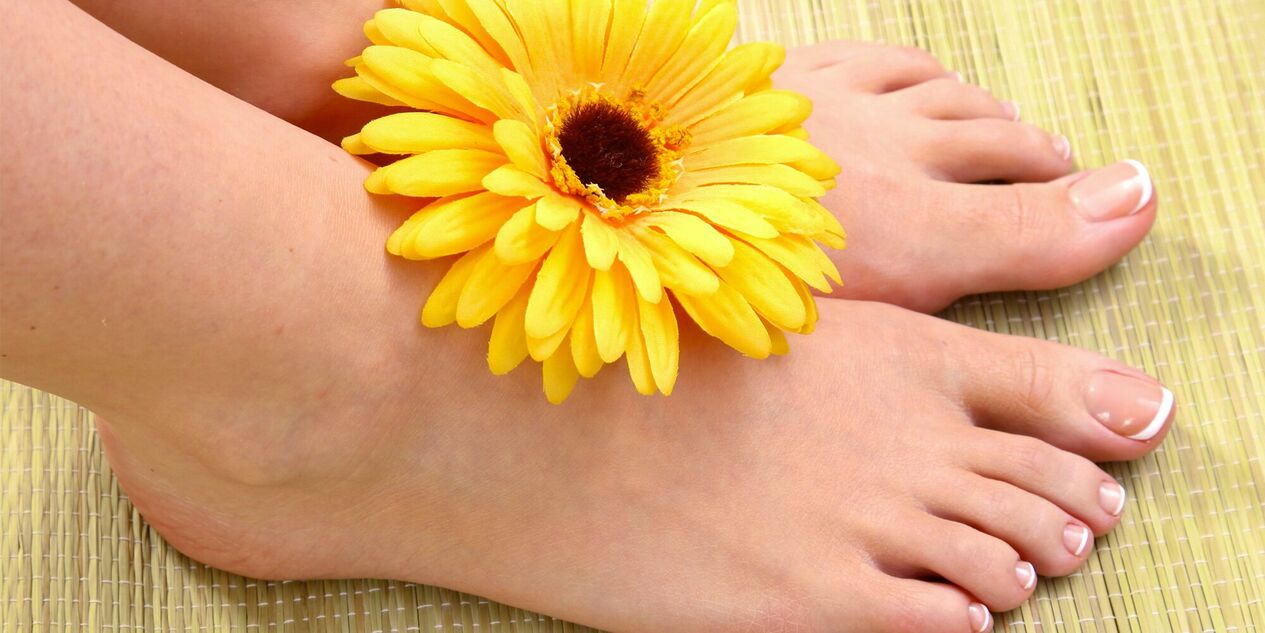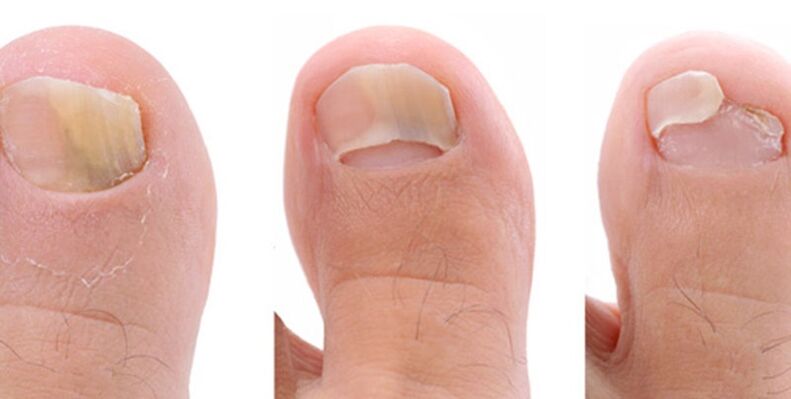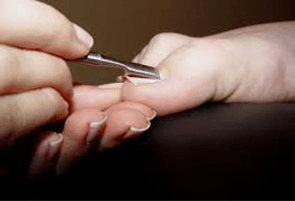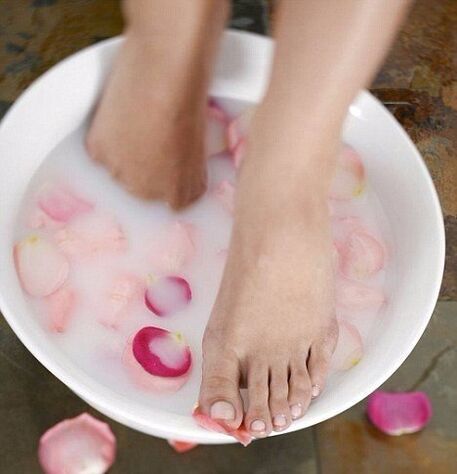Toenail fungus is a widespread infection caused by infection with opportunistic fungi and dermatophyte pathogens. About 20% of the adult population suffers from nail fungus and is virtually undetectable in children.

Causes of infection
Fungi are widespread in the environment, but damage to human nails and skin develops only under favorable conditions. With age, the acidic pH of the skin can change to alkaline, which is conducive to the growth of fungi. Infection usually occurs by contact, if personal hygiene norms are not followed, the source of infection may be a sick person or objects of shared use. Infection can occur in public places: swimming pools, saunas, gyms. And also in everyday life with the general use of slippers, socks, manicure accessories, towels and towels.
Predisposing factors for onychomycosis infection are:
- decreased immunity;
- poor foot circulation, including when wearing tight shoes;
- excessive sweating;
- diabetes;
- obesity;
- mechanical damage to nails;
- deformations and anatomical features of the feet.
Signs of toenail fungus

Nail fungus is a very persistent infection, the initial stage of the disease is expressed:
- nail plate stain, loss of gloss;
- increased fragility;
- itching and irritation of the skin around the affected nail;
- pain at the site of the lesion, especially when wearing tight shoes;
- detachment of a part of the nail from the nail bed.
With the advancement and inclusion of the entire nail plate in the process, new symptoms appear: the nail thickens and deforms significantly.
Depending on the degree of nail damage, there are three types of onychomycosis:
- Normotrophic - manifested by a distortion of the color of the nail from white to dark green. The color changes initially with dots or streaks and gradually covers the entire surface of the nail, while the thickness of the nail plate does not change and the gloss remains.
- Hypertrophic - expressed with spots, loss of luster and thickening and severe deformation of the nail. The nail is strongly exfoliated and partially destroyed;
- Atrophic - reflected by whitening, thinning and subsequent rejection of the affected area.
Which doctor treats the fungus?
You can diagnose the infection yourself, but only a doctor can confirm the diagnosis. If you notice a change in the color of the nail, increased fragility, you should consult a dermatologist. The physician prescribes a microscopic or diagnostic culture study to confirm the diagnosis. A portion of the affected nail is taken for analysis or scratched to nearby tissues. Timely detection of nail fungus greatly facilitates treatment and prevents the development of complications. Initiated onychomycosis is dangerous, as it can cause fungal eczema, aspergillosis, decreased immunity, infection of all nails, skin and other organs.
Treatment of nail fungus

The way of treating onychomycosis is determined by the doctor depending on the degree of change of the nail plate, the clinical form, the degree of hyperkeratosis and the length of the affected area. Topical agents (ointments, drops, sprays, varnishes) and general agents (antifungal drugs) are used for treatment.
As a rule, with small changes in the nail, medicines are used for local treatment. Prior to treatment with antifungal solutions, ointments, varnishes, the affected area of the nail should be removed surgically or with the help of keratolytic medications. This is necessary for better penetration of the antifungal medicine deep into the damaged tissues, which allows you to get rid of the fungus much faster.
Keratolytic drugs contribute to the softening of the nail and its easy and painless removal, produced in the form of plasters, which include urea or salicylic acid:
- ureaplast;
- suva ure me kinosol;
- kinosol-salicylic patch;
- onikoplast;
- chinosol-dimexid piece;
- mycospores (combined preparation).
Before gluing the plaster, it is necessary to scratch the top layer of the nail, then apply a therapeutic mass and glue it with an adhesive plaster, change the bandage every 1-2 days. Before the change, the affected areas of the nail are removed with scissors and antifungal agents are applied.
Creams, ointments and antifungal drops are:
- based on ketoconazole;
- clotrimazole derivatives;
- micanazole-based;
- oxycanazole derivatives;
- based on terbinafine;
- chloronitrophenol derivatives;
- naftifine based.
Ointments, creams and drops are preferably applied to the open nail bed 2-3 times a day, until the final restoration of the nail. These drugs are active against the vast majority of pathogens, but are unable to penetrate the entire depth of the nail plate.
Topical antiseptics - a solution of iodine, dyes, kinosol, organic acids are often used in the treatment of nail fungus, if it is impossible to use other means. The main advantage, the antiseptic is cheap and widely available. Local antiseptics, such as iodine, treat the affected nail up to three times a day, for a month. When applying the solution, it is advisable not to touch the surrounding skin to avoid burns. A burning sensation and tingling sensation helps to recognize the onset of exposure.
If local treatment is ineffective, antifungal tablets are prescribed additionally, prescribed by a specialist.
Properly selected combination therapy helps in faster cure of advanced onychomycosis. Also, the combined treatment with local and general therapy is prescribed for more than three affected nails, for persons over 50 years old and with slow nail growth. The use of combination therapy can significantly reduce the duration of the course of treatment.
Treatment of fungi with folk remedies

For the preparation of antifungal agents at home, you can use - apple cider vinegar and herbal preparations:
- mix in equal parts vegetable oil and apple cider vinegar, soak a cotton pad in the resulting solution and apply on the affected nail for 4 hours, for convenience, you can fix the bandage with an adhesive plaster. The procedure is performed daily for a month;
- for the treatment of a neglected process, a mixture of 9% vinegar with celandine helps, the resulting composition should be injected for a month. Then add 50 g of salt to it. The resulting product is used for foot baths 5-10 minutes before bedtime. It is important not to wipe your feet after bathing, but to let them dry on their own;
- to treat the affected nail, you can use an alcoholic solution of propolis, juice or grains of onion, garlic. A blend of lavender and tea tree oils also works well;
- herbal decoction for foot baths: mix in equal proportions the bark of oak, calendula, ponytail, verbena. Pour 50 g of the resulting mixture with boiling water and keep in a water bath for about 15 minutes.
Prophylaxis
Fungal damage to nails can be easily avoided with good personal hygiene:
- It is necessary to wash your feet daily with antiseptic agents.
- Dry your feet with a personal towel.
- Use a pumice stone to remove old skin, which is a good tool for fungal growth.
- Use medications that reduce foot sweating.
- Change socks, knee-high boots and tights every day.
- Wear loose, comfortable shoes. Do not wear wet shoes.
- Wear shoes when visiting pools and showers.
- Do not use other people's shoes, slippers, socks, towels, manicure accessories.
- Use pharmacological preparations for protection before visiting beaches, swimming pools, saunas.
















